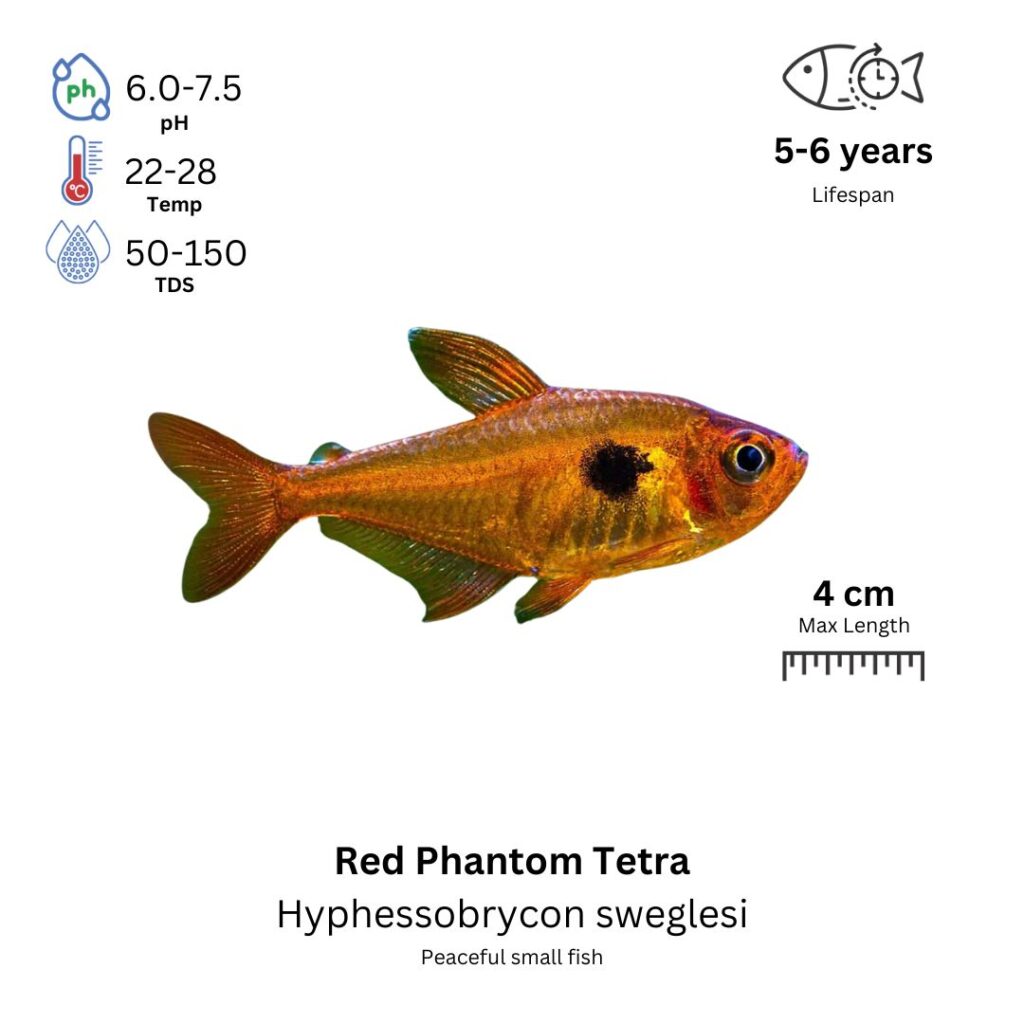Red Phantom Tetra
Hyphessobrycon sweglesi

Description
The Red Phantom Tetra is a small, strikingly beautiful species known for its vibrant red coloration, especially in males. The males of this species typically display a bright, almost translucent red body with a dark black or grey triangular patch around the tail region, giving them a “phantom” look. Females are slightly larger and have a more subdued coloration, usually a pale or light red with less intensity. Their sleek, streamlined bodies and long fins make them an attractive and graceful addition to community aquariums. These fish are peaceful, social creatures that do well in schools, often seen swimming together in the middle to upper parts of the tank.
Habitat Origin
Native to the slow-moving rivers and streams of South America, specifically the upper Orinoco River in Venezuela and Colombia, where they are found in slightly acidic, soft water with moderate to slow flow. They thrive in densely vegetated areas with ample hiding spots and submerged roots.
Aquarium
Ideal Number in Aquarium: At least 6 individuals, as they are schooling fish and feel more secure in groups.
Favorite Food

Red Phantom Tetras are omnivores and will accept a variety of foods, including high-quality flake food, micro pellets, and live or frozen foods such as brine shrimp, daphnia, and bloodworms. They will also consume small plant matter and algae, making them a great addition to planted tanks.
Behavior:
The Red Phantom Tetra is a peaceful, social fish that thrives in schools. They are active swimmers, often darting through the middle or upper sections of the tank. Their schooling behavior is more prominent when they are kept in groups, and their coloration is most vibrant when they are housed with their own kind. These fish are non-aggressive and generally get along well with other peaceful species. However, males may display some territorial behavior during breeding, especially around females.
Special Care:
Red Phantom Tetras prefer a well-planted tank with plenty of hiding spots, such as driftwood, rocks, and plants. Regular water changes and good filtration are important to maintain stable water conditions, as they are sensitive to poor water quality. Providing a slightly acidic to neutral pH and soft water conditions will help them thrive, mimicking their natural environment in the wild. These fish do best in tanks with moderate water flow, as they come from slow-moving waters in their native habitat.
Compatibility with Other Fish:
Yes, Red Phantom Tetras are ideal for peaceful community tanks with other small, non-aggressive species. They can coexist well with other tetras, rasboras, and peaceful bottom dwellers like Corydoras catfish. It’s important to avoid housing them with larger, more aggressive fish that may view them as food. Their schooling nature and beautiful coloration make them an excellent addition to community aquariums.
Breeding Tank Setup
For breeding Red Phantom Tetras, using a separate breeding tank is highly recommended. A dedicated environment allows for better control over water conditions and protects the eggs from being eaten by adult fish or other tank mates. A 10-gallon (38-liter) tank is sufficient for a small group, while 20 gallons (75 liters) is ideal for breeding multiple pairs. Maintain water parameters at pH 6.0–7.5, temperature 24–28°C (75–82°F), and hardness 4–12 dGH. A gentle sponge filter is ideal to avoid disturbing the eggs, and the substrate should consist of fine gravel or sand. Add Java moss, Hornwort, or floating plants to provide spawning surfaces and cover.
Conditioning for Breeding
To prepare Red Phantom Tetras for breeding, feed them a varied, high-quality diet for several days. This should include flake food or micro pellets, along with live or frozen foods like brine shrimp, bloodworms, and daphnia. Occasional feedings of vegetable-based foods such as chopped spinach or peas also support conditioning. Perform weekly water changes of 20–30%, and to trigger spawning, conduct a larger 50% change while slightly increasing the water temperature to 28°C (82°F) to simulate rainy-season cues that stimulate breeding in tetras.
Spawning Process
Spawning generally takes place early in the morning, especially after water parameters have been optimized. Males show off their vivid red coloration and court the females by swimming alongside them. Once the female releases eggs, the male immediately fertilizes them. Eggs are scattered and adhesive, attaching to plants and tank decor. A female can lay 30–100 eggs per session, and spawning may last for several hours. It is essential to remove the parents immediately after spawning, as they may eat the eggs if left in the tank.
Fry Hatching & Feeding
The eggs of Red Phantom Tetras hatch in approximately 24–36 hours, depending on water temperature. Fry will absorb their yolk sacs during the first few days. After this period, begin feeding infusoria or commercial liquid fry food. As the fry grow, introduce baby brine shrimp, microworms, or finely crushed flakes. Maintain stable water temperature (24–28°C) and perform small daily or every-other-day water changes (10–20%) to keep the tank clean. Avoid overfeeding, as uneaten food can quickly spoil the water and endanger the fry.
Breeding Tips & Warnings
Red Phantom Tetras typically become sexually mature at 6–12 months of age. Males are smaller, more slender, and more vividly colored, especially on the fins, while females are rounder and less vibrant, particularly when carrying eggs. To ensure breeding success, avoid sudden changes in water parameters, and always maintain high water quality with proper filtration. A calm, stress-free environment is crucial, so keep the breeding tank free from aggressive or overly active tank mates that could disturb the spawning process.
